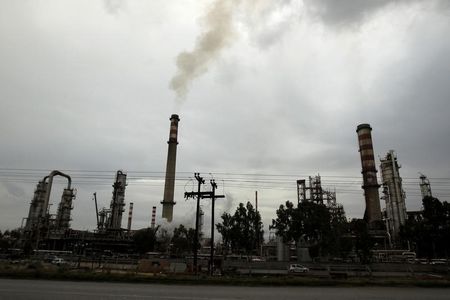Commodities
Analysis-California and Big Oil are splitting after century-long affair


© Reuters. FILE PHOTO: Oil is seen spilling from the Lakeview Gusher at the Midway Oil Field in Kern County, California, October 2, 1910. U.S. Department of the Interior/U.S. Geologic Survey/Handout via REUTERS/File Photo
2/2
By Sabrina Valle
(Reuters) – It is the end of an era for Big Oil in California, as the most populous U.S. state divorces itself from fossil fuels in its fight against climate change.
California’s oil output a century ago amounted to it being the fourth-largest crude producer in the U.S., and spawned hundreds of oil drillers, including some of the largest still in existence. Oil led to its car culture of iconic highways, drive-in theaters, banks and restaurants that endures today.
On Friday, however, the marriage will officially end. The two largest U.S. oil producers, Exxon Mobil (NYSE:) and Chevron (NYSE:), will formally disclose a combined $5 billion writedown of California assets when they report fourth-quarter results.
“They are definitely getting a divorce,” said Jamie Court, president of advocacy group Consumer Watchdog, which said the companies long ago stopped investing in California production, and now want to hive off their old wells there. “They’ve been separated for more than a decade, now they are just signing the papers,” he said.
Exxon Mobil last year exited onshore production in the state, ending a 25-year-long partnership with Shell PLC (LON:), when they sold their joint-venture properties.
The state’s regulatory environment has impeded efforts to restart offshore production, Exxon said this month, leading to an exit that includes financing a Texas company’s purchase of its offshore properties.
The No.1 U.S. oil producer’s asset writedown will cost about $2.5 billion and officially end five decades of oil production off the coast of Southern California.
Chevron will also take charges of about $2.5 billion tied to its California assets. It is staying but bitterly contesting state regulations on its oil producing and refining operations in the state, where it was born 145 years ago as Pacific Coast Oil Co.
California’s energy policies are “making it a difficult place to invest,” even for renewable fuels, a Chevron executive said this month. The company pumps oil from fields developed 100 years ago but has cut spending in the state by “hundreds of millions of dollars since 2022,” the executive said.
ENVIRONMENTAL AWAKENING
If oil companies fed California’s car culture, their oil spills spurred the U.S. environmental movement. A devastating oil well blowout in Santa Barbara in 1969 led to the National Environmental Policy Act that for the first time required federal agencies consider environmental effects of permitting decisions.
In the 70s and 80s, the state set curbs on drilling near homes and businesses and regulations on air pollution – rules that have been copied widely across the U.S. In 1996, California introduced reformulated gasoline to fight smog, developing the country’s most stringent and costly environmental standards.
That mixed legacy overshadowed oil’s economic contributions. California’s high-tech industry long ago replaced oil as a major employer and its governor, Gavin Newsom, has called for the state to ban sales of new gasoline-powered vehicles by 2035.
His administration last September filed a lawsuit targeting the oil industry for “lying to consumers for more than 50 years” about climate change. He signed into law a bill seeking to hold Chevron and other refiners liable for allegedly price-gouged consumers.
The American Petroleum Institute, the industry’s trade association, said climate lawsuits hurt “a foundational American industry and its workers” and represent “an enormous waste of California taxpayers resources.”
INDUSTRY IN DECLINE
For now, the acrimony makes the story of California and oil sound a lot like a tragedy.
“This is a green transition,” said Daniel Kammen, a professor of Energy at the University of California, who argues oil firms need to move to clean energy and away from fossil fuels. “There is a pathway for these companies. But if they chose otherwise, they are dinosaurs.”
Oil production in the state has been on a steady decline for almost four decades. Crude output, including at its historic Kern County fields in southern California, is off by a third since its 1.1 million-barrel-per-day peak in 1985.
The state has lacked new oil development projects and the legacy fields that produce heavy oil have not been suitable for state mandates for high quality gasoline.
As of September, more than 50% of oil drilling permits issued to companies have gone unused, according to the California Department of Conservation. Unemployment in oil producer Kern County is at 7.8%, compared with the overall 4.9% average for the state.
And California today has six times more clean-energy as oil-related jobs.
“California can’t have both,” said UC Berkley’s Kammen, who formerly was a Science Envoy in the Obama administration. “That means there is no room for oil and gas after that.”
Commodities
Gold and silver to continue to appreciate – Julius Baer

Investing.com – With another day of gains in and futures, the Swiss group Julius Baer has decided to change its outlook on commodities to constructive. The group now believes that both metals have the potential for further increases, as stated in a note sent to clients and the market on Friday morning.
The group mentioned that, in addition to U.S. monetary policy, the gold market is still dominated by Asia. “We have to recognize that the region’s willingness to pay for gold as a hedge against economic and geopolitical risks appears even greater than we expected,” said Carsten Menke, head of next-generation research at Julius Baer.
Weaker-than-expected U.S. economic data have revived hopes for interest rate cuts by the Federal Reserve (Fed, the U.S. central bank), boosting gold and silver prices. This could “be the missing incentive for safe-haven seekers in the Western world to return to the markets,” he added.
Central Bank Purchases in Focus
Central banks have been buying gold more for geopolitical reasons than economic ones, according to Julius Baer. In China, for example, there is a desire to reduce dependence on the U.S. dollar – important for avoiding potential sanctions.
The People’s Bank of China is believed to be responsible for at least 30% to 50% of all central bank purchases over the past two years. Although it shows signs of being price-sensitive, “its willingness to pay has increased as gold prices rise,” notes Julius Baer. It is expected that other monetary authorities will follow the same steps, moving away from the U.S. dollar.
remove ads
.
***
Want to leverage your strategies with stocks of companies related to commodities?
Then come to InvestingPro! By becoming a member of InvestingPro, you get access to features such as:
- ProPicks: AI-managed stock portfolios with proven results.
- ProTips: Quick and straightforward tips to simplify complex financial information.
- Advanced stock filter: Find the stocks that best meet your expectations based on hundreds of financial metrics.
- Turbo navigation: Investing.com pages load much faster, without any ads.
- Institutional-level financial data for thousands of stocks: Ideal for investors who want to conduct their own detailed evaluations.
- And many more services to be added soon!
Enjoy all this with an extra discount on 1 or 2-year Pro and Pro+ plans. Enter the code INVESTIR and enjoy!
Commodities
Goldman Sachs discusses what’s next for natural gas prices

Over the past three weeks, US prices have surged 30% to above $2.50 per million British thermal units (mm/BTU), fueled by production declines and increased feedgas demand for liquified natural gas (LNG) exports.
Moreover, recent producer cuts, maintenance events, and Freeport LNG’s normalization of gas demand post-outage have contributed to this rise. Cheniere’s announcement of no heavy maintenance for its liquefaction trains this year also supports higher prices.
In a Thursday note, Goldman Sachs strategists said the return of gas prices above $2/mmBtu aligns with their expectations, as production curtailments “would ultimately lead to lower storage congestion risks for this summer.”
“That said, we see only limited further upside from current levels, with stronger gas prices risking a return of congestion concerns,” they added.
Goldman notes that prices above $2/mmBtu reduce gas competitiveness compared to coal, with a $0.50/mmBtu increase potentially cutting gas demand by 1 billion cubic feet per day (Bcf/d), especially in shoulder months.
Moreover, higher prices may prompt the restart of previously shut-in wells. EQT (ST:), the largest producer in the Appalachia region, indicated it would resume production if prices sustainably exceed $1.50/mmBtu. And while Appalachia prices haven’t risen as much as NYMEX, the local hub has averaged $1.44/mmBtu month-to-date, up 10¢ from last month, strategists highlighted.
Elsewhere, European gas prices have also risen this summer, though less sharply than in the US.
Title Transfer Facility (TTF) prices increased 18% over the past three months to around 30 euros per megawatt-hour (MWh), holding steady in May.
remove ads
.
However, unlike the US market, this rally lacks fundamental support, with Northwest (NW) European gas storage at record-high levels, Goldman strategists pointed out.
“To be sure, NW European LNG imports have remained weak relative to last year – and are likely to get weaker in the coming weeks owing to a seasonal decline in global LNG production, exacerbated by outages at Australia’s Gorgon export project,” they said.
“Going forward, we expect healthy non-European demand for LNG to continue to incentivize a decline in European LNG imports vs last year,” they continued.
Commodities
Gold prices trim some weekly gains on tempered rate cut hopes

Investing.com– Gold prices fell slightly on Friday, trimming some of their gains for the week as comments from a slew of Federal Reserve officials offered a more sobering outlook on interest rate cuts.
The yellow metal had risen to nearly $2,400 an ounce this week in the immediate aftermath of some soft U.S. economic readings. But it pulled back from these levels on Thursday and Friday.
steadied at $2,377.40 an ounce, while expiring in June fell slightly to $2,381.10 an ounce by 00:19 ET (04:19 GMT).
Gold retreats as Fed officials downplay rate cuts, but weekly gains due
The yellow metal fell on Thursday after a string of Fed officials cautioned against bets on immediate reductions in interest rates.
Several members of the central bank’s rate setting committee said the central bank will need much more convincing that inflation was coming down beyond a marginally soft inflation reading for April.
This saw traders begin pricing out some expectations for a rate cut in September. The and also rebounded from earlier losses this week.
Still, some softer-than-expected readings put gold on course for a 0.7% weekly gain.
The yellow metal was also in sight of a record high of above $2,430 an ounce, although it appeared unlikely the level would be met in the near-term.
Other precious metals retreated on Friday, but were set for bumper weekly gains. fell 0.2% but were trading up 6.2% for the week, while fell 0.4% but were up 4.5% this week.
remove ads
.
Copper mixed amid middling China cues
Among industrial metals, one-month copper futures tumbled from two-year highs tracking middling economic data. But three-month copper futures pushed higher and were set for a stellar week as markets bet on tighter supplies and an eventual demand recovery in the coming months.
on the London Metal Exchange rose 0.6% to $10,445.0 a ton, while rose 0.3% to $4.8935 a pound.
Data from China on Friday painted a mixed picture of the economy. While grew more than expected, growth slowed and shrank at an accelerated pace. Growth in Chinese also slowed.
The readings presented a muddled outlook for the world’s biggest copper importer, as it rolled out more stimulus measures to shore up growth.
Three-month copper futures gained on the prospect of a demand recovery, and were up nearly 4% this week. They were also at two-year highs.

 Forex2 years ago
Forex2 years agoForex Today: the dollar is gaining strength amid gloomy sentiment at the start of the Fed’s week

 Forex2 years ago
Forex2 years agoHow is the Australian dollar doing today?

 Forex1 year ago
Forex1 year agoUnbiased review of Pocket Option broker

 Forex2 years ago
Forex2 years agoDollar to pound sterling exchange rate today: Pound plummeted to its lowest since 1985

 Cryptocurrency2 years ago
Cryptocurrency2 years agoWhat happened in the crypto market – current events today

 World2 years ago
World2 years agoWhy are modern video games an art form?

 Stock Markets2 years ago
Stock Markets2 years agoMorgan Stanley: bear market rally to continue

 Economy2 years ago
Economy2 years agoCrude oil tankers double in price due to EU anti-Russian sanctions

































